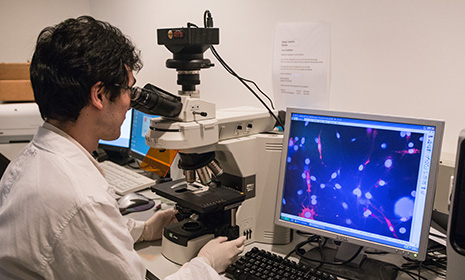HKU leads the first health study in Asia which shows that long-term exposure to fine particles PM2.5 is associated with mortality in Hong Kong elderly
The effect of air pollution on one’s health is always a great concern. However, there are few related studies in Asia on this aspect. A research team led by Dr Wong Chit-ming, Associate Professor of the School of Public Health, Li Ka Shing Faculty of Medicine, The University of Hong Kong (HKU) has performed the first health effect study for long-term exposure to fine particles (particulate matter with aerodynamic diameter <2.5 μm, i.e. PM2.5) in Asia. The study reveals that the higher level of PM2.5, the higher the mortality risk, which could provide scientific evidence for formulating air pollution related policies. The details and results of the study have been published in the latest issue of the Environmental Health Perspectives, (http://ehp.niehs.nih.gov/1408264/) this morning.
Research Implications
Dr Wong Chit-ming said that, "The study findings are of public health importance, particularly in Asia where air quality is poor and local data on long-term effects of PM2.5 to support policy on air quality management are scarce. The use of satellite data provides a readily accessible and affordable approach for estimation of a sufficient range of individual exposures in Hong Kong. This approach can expand the capacity to conduct environmental accountability studies in areas with few measurements of PM2.5."
Research Results
Through statistical modeling with adjustment for individual and area level confounding factors, the study found that each 10 units (in μg/m3) increase in PM2.5 concentration was associated with excess mortality of 14% for all natural causes, 22% for cardiovascular causes, 42% for ischemic heart disease, and 24% for cerebrovascular disease.
The findings show that residing in area with higher levels of PM2.5 is associated with excess mortality and corroborate the existing evidence for a causal relationship between adverse health outcomes and PM2.5. These research findings provide support for the formulation and implementation of policies for the mitigation of the air pollutant and its disease burden on the population.
Research Method
The study included 66,820 participants aged 65 or older, who were enrolled and interviewed in all 18 Elderly Health Centres of the Department of Health in 1998-2001, and obtained the mortality outcomes of the 16,415 participants who had deceased during the period from enrolment until 2011, through record linkage to the death registry. It used the aerosol optical depth (AOD) data monitored by two US National Aeronautics and Space Administration (NASA) satellites to estimate PM2.5 concentrations in 1ž1 km grids in all land areas of Hong Kong. The residential addresses of the participants were geo-coded and their exposures to PM2.5 were estimated. By comparison of mortality risks between areas of different exposure levels using Cox regression modeling, the excess risk associated with each unit increase in PM2.5 concentration was estimated.
About the Research Team
The study was led by Dr Wong Chit-ming, Associate Professor of School of Public Health, Li
Ka Shing Faculty of Medicine, HKU. Others collaborators are environmental and public health researchers and medical professionals from four institutes in Hong Kong and the UK, namely The University of Hong Kong's School of Public Health, the University of Birmingham's School of Health and Population Sciences, the University of Science and Technology's Division of Environment, and the Hong Kong SAR Government's Department of Health. This research is supported by the Wellcome Trust.

Dr Wong Chit-ming (Front Row Middle), Associate Professor of the School of Public Health, Li Ka Shing Faculty of Medicine, The University of Hong Kong, who led the study, takes a group photo with Dr Thach Thuan-quoc (Front Row Left), Scientific Officer, Dr Tian Linwei (Front Row Right), Associate Professor of the School and the research team.








.png)
